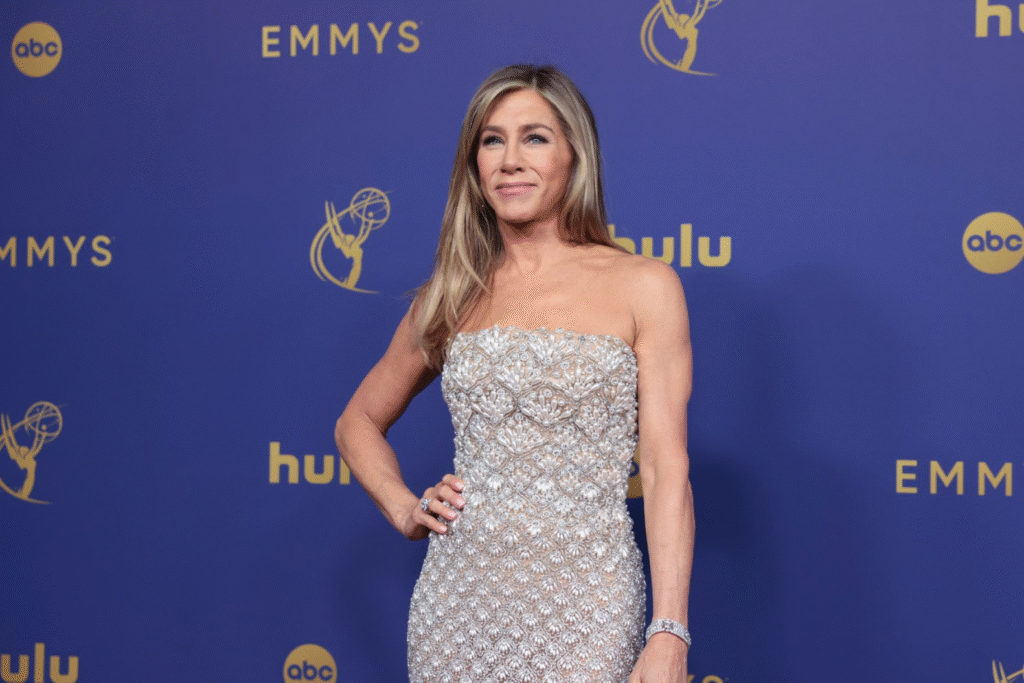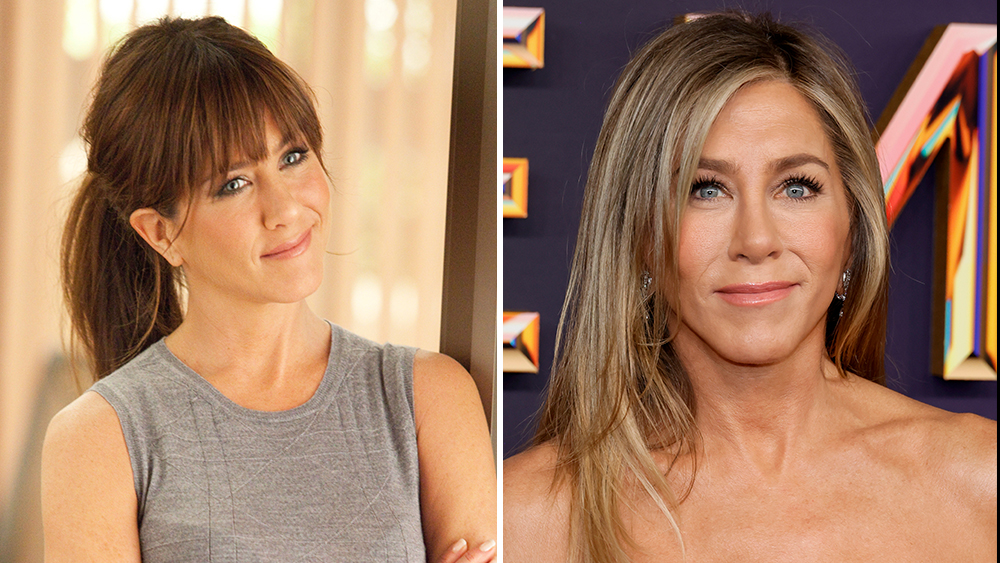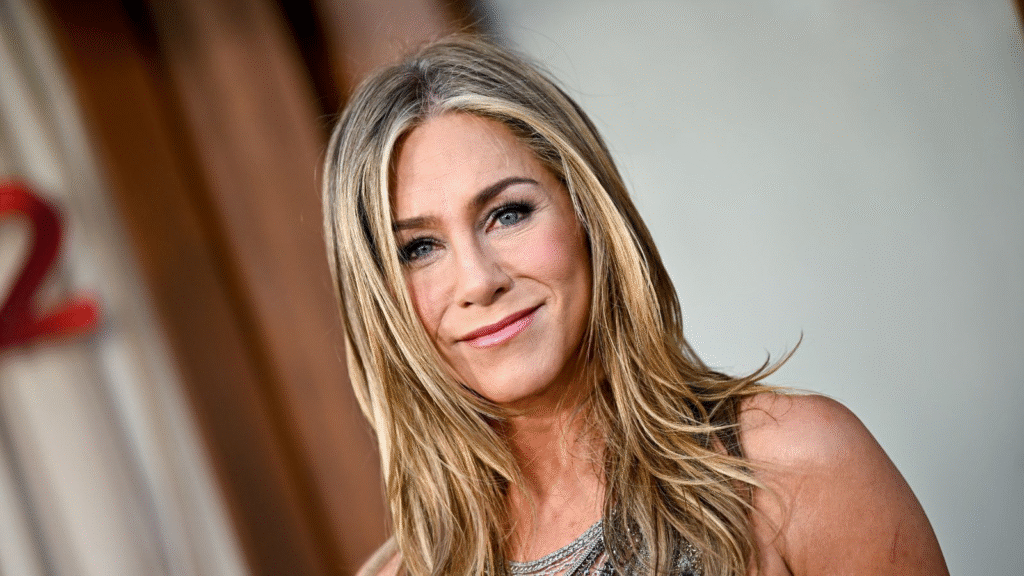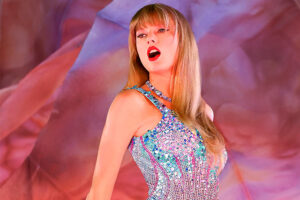Why Jennifer Aniston Is Still America’s Sweetheart at 55
There are stars who burn brightly and fade. There are…
There are stars who burn brightly and fade. There are icons who are respected from a distance. And then there is Jennifer Aniston.
For more than thirty years, she has occupied a unique and seemingly unshakeable position in the cultural landscape. It’s a space that transcends mere celebrity. She is a constant, a fixed point in the chaotic constellation of Hollywood. The title most often bestowed upon her—”America’s Sweetheart”—feels both quaintly old-fashioned and, somehow, completely, undeniably accurate, even as she celebrates her 55th birthday in 2024.
But why? In an industry notorious for its fickle nature, in a world that cycles through trends and personalities with breathtaking speed, how has Jennifer Aniston managed not just to stay relevant, but to maintain a deep, affectionate, and protective bond with the global public?
Jennifer Aniston Addresses the Many Rumors About Her & She Brings Out Her Dog Clyde!
This is not a story of luck. It is not an accident of good timing or the result of a single, iconic role. The endurance of the Jennifer Aniston brand is a masterclass in resilience, strategic evolution, and the quiet cultivation of an authentic relationship with an audience that has grown up alongside her. It is the story of how a television character became a cultural touchstone, how a woman’s public heartbreak forged a narrative of grace, and how a savvy career strategy transformed a beloved actress into a respected producer and wellness mogul.
Her journey is a roadmap for navigating the treacherous terrain of modern fame. She has weathered unimaginable public scrutiny, pivoted her career with precision, and built a business empire, all while preserving the “girl next door” accessibility that first made us fall in love with her.
To understand why Jennifer Aniston is still America’s Sweetheart at 55, we must deconstruct the pillars of her enduring appeal. We must look at the foundation laid by Rachel Green, the crucible of the tabloid era that forged her into a symbol of resilience, the shrewd career choices that cemented her persona while simultaneously demanding respect, and the modern-day evolution into a wellness icon and business leader who has taken control of her own narrative. This is the story of the Aniston Constant.
Chapter 1: The Foundation – The Rachel Green Phenomenon and the Birth of an Archetype
Everything begins with Friends. It is impossible to overstate the importance of the NBC sitcom, which premiered in 1994, as the bedrock of Jennifer Aniston’s entire career and public persona. For ten seasons and 236 episodes, she wasn’t just playing a character; she was helping to create a new, modern archetype of American womanhood. Rachel Green was not just a role; she was a cultural event.
From Runaway Bride to Relatable Heroine
When we first meet Rachel, she is a spoiled, helpless runaway bride, bursting into Central Perk in a wedding dress, having just abandoned her comfortable but passionless future. She is utterly dependent, cutting up her father’s credit cards as a symbolic, terrifying first step into adulthood.
This starting point was crucial. It made her an underdog. Over the next decade, audiences watched her evolution in real-time. She went from a clumsy waitress to a personal shopper at Bloomingdale’s to a successful executive at Ralph Lauren. We saw her navigate heartbreak, career setbacks, financial independence, and unexpected single motherhood. This wasn’t a static character; it was a journey. And because that journey mirrored the aspirations and anxieties of millions of young people (particularly women) coming of age in the 90s, it created a deep, personal connection.

Jennifer Aniston’s portrayal was key. She imbued Rachel with a perfect blend of vulnerability, comedic timing, and innate warmth. Her “Rachelisms”—the head tilts, the hand gestures, the signature vocal fry—made the character feel real, like someone you knew. She could be ditzy, she could be vain, but she was always, fundamentally, good. You rooted for her because her triumphs felt earned and her mistakes felt human.
“The Rachel” Haircut: A Symbol of Cultural Power
No discussion of this era is complete without mentioning “The Rachel.” The layered, shoulder-length shag, created by stylist Chris McMillan, became a global phenomenon. It was more than a hairstyle; it was a cultural shorthand. Women across the world walked into salons with a picture of Jennifer Aniston and walked out feeling a little closer to her aspirational-yet-accessible style.
The haircut’s popularity (which Aniston herself later admitted she found difficult to maintain) was the first tangible evidence of her immense influence. It demonstrated that she had the power to shape trends on a massive scale. It was a testament to her appeal: women wanted to be her, and men wanted to be with her. This combination is the classic formula for a “sweetheart,” but Aniston’s version felt fresh and modern. She wasn’t the demure, damsel-in-distress sweetheart of a previous era; she was the cool, funny, independent best friend you wanted in your corner.
Friends for Life: The Enduring Power of Syndication and Streaming
The final episode of Friends aired in 2004, but Rachel Green never went away. Through constant syndication and its later, explosive second life on streaming platforms like Netflix and HBO Max, the show has remained a cultural touchstone.
This has had a profound effect on Aniston’s longevity. Every year, a new generation of teenagers and young adults discovers the show for the first time. For them, Jennifer Aniston is not a 55-year-old actress; she is eternally 20-something Rachel Green, navigating life and love in New York City. The show acts as a constant, looping introduction to her brand, reinforcing the core attributes of warmth, humor, and relatability.
When these new fans then look up Jennifer Aniston in the present day, they see a woman who has aged with incredible grace, who is still working at the top of her game, and who embodies the wellness and success that Rachel Green was striving for. The past and present versions of her brand don’t conflict; they complement each other perfectly.

The Friends: The Reunion special in 2021 was a global event that underscored this enduring love. Seeing the cast together again, sharing genuine affection and nostalgia, was a powerful reminder of the bond they shared, and by extension, the bond the audience felt with them. Jennifer Aniston, often seen as the show’s breakout star, was at the center of it, the warm, emotional core that held the group together.
The foundation of Rachel Green is unshakable. It provided Jennifer Aniston with a lifetime supply of goodwill and a permanent place in the pop culture pantheon. But it was what she built on top of that foundation, particularly in the face of immense personal challenges, that would truly cement her status as an icon.
Chapter 2: The Crucible – Forging Grace Under Unimaginable Public Pressure
If Friends made her a star, the mid-2000s made her a legend. This was the period where her private life was thrust into the public sphere in the most brutal way imaginable. The end of her marriage to Brad Pitt and his subsequent relationship with Angelina Jolie was not just a celebrity breakup; it was a global media spectacle, a narrative that cast her as the wronged woman, the victim in a Hollywood love triangle.
This period, which could have destroyed her career, instead became the crucible in which her “sweetheart” persona was forged into something much stronger: a symbol of resilience and grace under pressure. The public didn’t just love her anymore; they felt a fierce need to protect her.
The “Team Jen” vs. “Team Angie” Phenomenon
The media narrative was relentless and reductive. It created a binary choice for the public: you were either “Team Jen” or “Team Angie.” Angelina Jolie was cast as the sultry, dangerous “other woman,” while Jennifer Aniston was the wholesome, loyal, girl-next-door wife who had been left heartbroken. T-shirts were printed. Tabloid covers screamed sensational headlines week after week. Her pain was commercialized and consumed by millions.
In the face of this onslaught, Jennifer Aniston did something remarkable: almost nothing. She didn’t engage in a public war of words. She didn’t release tearful statements. She didn’t feed the media machine that was so desperate for her reaction. Instead, she chose a path of quiet dignity.
Her one major public statement on the matter came in a now-famous 2005 Vanity Fair interview. It was a masterclass in controlled vulnerability. She admitted her pain and sadness, making her human and relatable. She famously commented on Pitt’s apparent lack of a “sensitivity chip,” a perfectly pitched line that was both pointed and poignant. But she refused to be a victim. The overwhelming message of the interview was one of strength, optimism, and a determination to move forward.
The Power of Silence and Work
Her strategy was simple but brilliant: she put her head down and went to work. As the tabloid drama raged, she released the film The Break-Up (2006) alongside Vince Vaughn. The timing was almost poetic. The film was a huge commercial success, proving that her box office appeal was not only intact but perhaps even enhanced by her personal situation. The public showed up for her, turning a movie ticket into a vote of support.
By refusing to play the media’s game, she took control of her own narrative. She communicated her strength not through words, but through her actions. She kept working. She kept showing up on red carpets, looking incredible. She kept succeeding. This quiet defiance was incredibly powerful. It subverted the victim narrative the tabloids were so desperate to sell. She was not the “poor Jen” of the headlines; she was Jennifer Aniston, a successful, resilient woman who was handling an awful situation with more class than most could ever muster.
The Long-Term Impact: From Sympathy to Respect
This period had a profound and lasting impact on her public image. The sympathy she garnered was immense, but over time, that sympathy morphed into deep respect. She had faced the ultimate public humiliation and had emerged not bitter or broken, but stronger and more poised than ever.
This narrative of grace under fire became a cornerstone of her brand. It added a layer of depth to her “sweetheart” image. She was not just the funny, pretty girl from Friends; she was a survivor. This experience forged an unbreakable bond with her audience, particularly with women who had faced their own heartbreaks and betrayals. She became an aspirational figure not just for her style or her career, but for her emotional fortitude.

Years later, in 2022, she would speak with a new level of candor in an Allure interview, revealing her private struggles with IVF during that tumultuous time. This revelation, shared on her own terms decades later, only deepened the public’s admiration. It reframed the “selfish career woman” narrative that some had tried to pin on her and revealed a hidden layer of pain she had silently carried. Once again, she demonstrated that true strength lies not in broadcasting your struggles, but in choosing when and how you share your story.
The crucible of the 2000s was the defining test of her career. She passed it with a quiet dignity that transformed her from a beloved TV star into an enduring cultural icon.
Chapter 3: The Rom-Com Queen – Cementing the Sweetheart Persona on the Big Screen
With the end of Friends in 2004, Jennifer Aniston faced the classic sitcom star’s dilemma: how to transition to a successful and sustainable film career without being forever typecast. Her solution was a shrewd and calculated strategy. Instead of running from the persona that had made her famous, she leaned into it, embracing the romantic comedy genre and becoming its undisputed queen for over a decade.
This was not a lazy choice; it was a brilliant brand-building exercise. Her film roles of this era reinforced and expanded upon the “sweetheart” qualities the public already loved, making her a reliable, bankable, and beloved movie star.
The Aniston Formula: Relatable, Funny, Aspirational
Jennifer Aniston’s rom-coms followed a loose but effective formula. She almost always played a character who was relatable in her struggles but aspirational in her ultimate success and style. She was the everywoman, but the most charming, funny, and best-dressed everywoman you could imagine.
- The Break-Up (2006): As mentioned, this film was a savvy first major post-Friends vehicle. It was an “anti-rom-com” that played with the genre’s conventions, but her character, Brooke, was pure Aniston: a smart, art gallery manager frustrated by her schlubby boyfriend. She was sympathetic, funny, and audiences were firmly on her side.
- Marley & Me (2008): This film was a cultural juggernaut. Co-starring Owen Wilson, it was more of a life comedy-drama than a pure rom-com. Playing one half of a couple navigating marriage, careers, children, and life with a chaotic but lovable dog, Aniston tapped into a deep well of warmth and maternal energy. The film’s heartbreaking conclusion solidified her image as an actress who could deliver genuine, heartfelt emotion. It was a four-quadrant hit that broadened her appeal to families.
- He’s Just Not That Into You (2009): In this ensemble cast, she played the character who was perhaps most emblematic of the single woman’s struggle, navigating a long-term relationship with a partner who won’t commit. Her storyline was the emotional anchor of the film.
- Just Go with It (2011): Teaming up with Adam Sandler, she proved her comedic chemistry with one of the genre’s biggest stars. The film was a massive commercial success and showcased her ability to handle broad physical comedy while still being the emotional core of the story.
These films, along with others like The Bounty Hunter and We’re the Millers, were not always critical darlings, but they were consistently popular with audiences. They delivered on a specific brand promise: if you buy a ticket to a Jennifer Aniston movie, you will get a funny, heartwarming, and satisfying experience, anchored by a performance of immense charm and charisma. She became a cinematic comfort food, a reliable choice for a great night out.
The “America’s Sweetheart” Feedback Loop
Her film career created a powerful feedback loop. Her roles as the lovable, put-upon, but ultimately triumphant heroine in these films reinforced the public’s perception of her, which was largely shaped by the “Team Jen” narrative from her personal life.
The public wanted to see her win on screen because they felt she deserved to win in real life. They wanted to see her find love, success, and happiness. Her films provided that catharsis. Each successful rom-com further cemented her status as America’s Sweetheart, a title that in turn made her even more bankable in that very genre. It was a self-perpetuating cycle of commercial and cultural success.
By dominating this space, she wisely avoided competing in genres where she might have been less convincing or where she would have had to fight against her established persona. Instead of trying to be a gritty action star or a brooding indie darling (at least, not yet), she solidified her brand identity, building a loyal cinematic audience on top of her already massive television fanbase.
Chapter 4: The Pivot – The Serious Actress and the Pursuit of Respect
For any actor defined by a beloved persona, there comes a time when the desire for a new challenge, for critical respect, becomes paramount. While Jennifer Aniston had built a hugely successful career as a rom-com queen, she was also smart enough to know that longevity requires demonstrating range. Throughout her career, and with increasing focus in the 2010s, she made strategic pivots into dramatic territory.
These roles were not just about changing her image; they were a deliberate pursuit of artistic validation. They were her way of saying to the industry and the audience: “I am more than just Rachel Green. I am more than the girl next door. I am an actress.”
The Early Signs: The Good Girl
The first major sign of this ambition came early, in 2002, even while Friends was still on the air. She starred in the bleak indie film The Good Girl, directed by Miguel Arteta. She played Justine, a bored, lonely, and morally compromised discount store clerk who embarks on a dreary affair with a younger co-worker.
It was a radical departure. Aniston deglamorized herself completely, swapping Rachel’s designer wardrobe for a drab retail uniform. She suppressed her natural charisma to portray a woman suffocated by her dead-end life. The performance was a revelation and earned her rave reviews. Critics praised her courage and her surprising depth. While the film was not a box office smash, it was a critical success that planted a seed: Jennifer Aniston had serious dramatic chops.
The Oscar Push: Cake
The most overt and ambitious bid for critical acclaim came in 2014 with the film Cake. Aniston played Claire Simmons, a woman suffering from chronic pain and grappling with the emotional trauma of a recent tragedy that led to the loss of her son and left her with severe physical scars.
Her physical transformation was stark. She wore no makeup, allowed her hair to be stringy and unwashed, and adopted a rigid, pained physicality that was difficult to watch. The performance was raw, unflinching, and entirely devoid of her signature charm. It was a complete immersion into a character defined by agony.
Aniston campaigned hard for the role during awards season. She earned Golden Globe and Screen Actors Guild nominations, and there was significant Oscar buzz. While she was ultimately snubbed by the Academy—a decision many saw as a major oversight—the effort was a success in its own right. It forced Hollywood to see her in a new light. She had proven, beyond a shadow of a doubt, that she was capable of carrying a demanding, complex drama. The respect she had been seeking was granted.
The Morning Show: The Culmination
Her most significant and triumphant pivot came in 2019 with the launch of Apple TV+’s flagship series, The Morning Show. Here, she not only starred but also served as an executive producer, giving her complete creative control.
Her character, Alex Levy, is a masterstroke of meta-casting. Alex is a long-reigning “America’s Sweetheart” of morning television whose carefully constructed public image is shattered when her co-host of 15 years (played by Steve Carell) is fired amidst a #MeToo scandal. The show follows her struggle to maintain control of her career, navigate a treacherous corporate landscape, and confront her own complicity and buried rage.
The parallels to Aniston’s own life are impossible to ignore. Alex Levy is a woman who has lived in the public eye for decades, whose personal life has been tabloid fodder, and who must fight to be seen as a powerful professional rather than just a beloved face. In Alex, Aniston found a vehicle to explore all the themes of her own career: the pressure of being a public woman, the fight for control, the gap between a public persona and a private reality, and the righteous anger of a woman who is tired of being underestimated.
Her performance is a tour de force, arguably the best of her career. She is at once sympathetic and monstrous, powerful and vulnerable, funny and terrifying. It earned her a Screen Actors Guild Award and universal critical acclaim. The Morning Show is the ultimate culmination of her journey. It allows her to deconstruct the very “America’s Sweetheart” archetype she helped create, infusing it with a dark, complex, and thrillingly modern edge. It proves, once and for all, that at 55, she is doing the most challenging and rewarding work of her life.
Chapter 5: The Wellness Icon – Redefining Agelessness in Hollywood
As Jennifer Aniston and her original fanbase have aged, a new and powerful pillar has been added to her brand: her status as a wellness and lifestyle icon. In an industry obsessed with youth, she has become a symbol of healthy, vibrant, and powerful aging. She has managed to turn the process of getting older—often a liability for actresses in Hollywood—into one of her greatest assets.
This evolution feels completely organic. It’s a natural extension of the “California girl” image she has always projected, but now it’s infused with the wisdom and discipline of a woman in her fifties. She is not desperately trying to look 25; she is redefining what it means to be 55.
The Aniston Aesthetic: Health, Not Hype
Her approach to wellness is rooted in a philosophy of consistency and balance, which feels both aspirational and achievable. Through interviews and her carefully chosen brand partnerships, she has cultivated an image of someone who prioritizes health from the inside out.
- Fitness: She is famous for her dedication to yoga, boxing, and regular workouts. Her physique is strong and toned, the result of consistent effort, not extreme measures. This projects an image of discipline and self-care.
- Nutrition: She speaks about a diet rich in healthy proteins and vegetables, but she is also open about enjoying pasta and the occasional martini. This balance makes her approach feel realistic and not punitive.
- Mindfulness: She has been a longtime practitioner of meditation and has spoken about its importance for her mental health, adding a crucial layer of inner wellness to her public-facing brand.
Strategic Brand Partnerships: Smartwater, Aveeno, and Vital Proteins
Her endorsement deals are not random; they are strategic extensions of her wellness brand.
- Smartwater: Her decades-long partnership with Smartwater has been a masterclass in brand alignment. The product’s image—pure, clean, simple—perfectly mirrors her own.
- Aveeno: As the face of this skincare brand, she promotes products known for their natural ingredients and gentle effectiveness. It aligns with her “natural beauty” aesthetic, rather than a brand promising miraculous, anti-aging plastic surgery in a bottle.
- Vital Proteins: Her partnership with this collagen supplement company was a savvy move into the booming wellness market. She later became the company’s Chief Creative Officer, demonstrating a deeper level of business involvement.
These partnerships reinforce her authority in the wellness space. They are not just about a paycheck; they are about curating a lifestyle brand that is authentic to her.
LolaVie: Owning the Narrative (and the Product)
The ultimate expression of her wellness-meets-business brand came in 2021 with the launch of her own haircare line, LolaVie. After decades of being defined by her hair, she finally took ownership of it.
The brand’s philosophy is pure Aniston: “less is more.” It launched with just two products, emphasizing high-quality, plant-based, cruelty-free ingredients. It is minimalist, effective, and chic. LolaVie is not about chasing trends; it’s about creating timeless, healthy staples. By launching her own brand, she moved from being a brand ambassador to a brand creator, a powerful shift that gives her full control and a direct-to-consumer relationship with her audience.
Her status as a wellness icon is crucial to her enduring appeal at 55. She provides a roadmap for aging with strength, grace, and vitality. For the millions of women who grew up with her, she is not just a nostalgic figure from their youth; she is an inspiring guide for their present and future.
Chapter 6: The Mogul and the Private Citizen – The Art of Control
The final pillar of the Aniston Constant is perhaps the most modern and most indicative of her savvy: her mastery of control. Jennifer Aniston, the mogul and the private citizen, has learned how to engage with the world entirely on her own terms. After decades of having her narrative shaped by others, she has quietly and effectively taken the reins.
From Actress to Producer: Echo Films
Early in her career, she recognized the importance of having power behind the camera. She founded her production company, Echo Films, which has been involved in many of her projects, including Cake, The Switch, and the Netflix hit Dumplin’. This move into producing was critical. It gave her a say in the stories she wanted to tell, the roles she wanted to play, and the talent she wanted to work with.
Her role as an executive producer on The Morning Show is the most prominent example of this power. She is not just an employee of Apple TV+; she is a creative force shaping one of its most important shows. This shift from actress-for-hire to producer-in-charge is a key element of her evolution. It adds a layer of respect and authority to her public persona. She is not just a sweetheart; she is a boss.
The Instagram Masterstroke
For years, Jennifer Aniston famously resisted joining social media. She was one of the last major holdouts, which only added to her mystique. When she finally joined Instagram in October 2019, she did it in the most spectacular way possible.
Her first post was a grainy, candid selfie with her five Friends co-stars. The internet essentially broke. She gained millions of followers in hours, setting a Guinness World Record. Her arrival was not a tentative dip into the digital world; it was a major cultural event, executed with perfect timing and strategy.
Since then, her use of the platform has been a case study in perfect brand management. Her feed is a curated but authentic-feeling mix:
- Nostalgia: She posts throwback clips from Friends and other projects, delighting her longtime fans.
- Behind-the-Scenes: She shares candid moments from photoshoots and film sets, giving a glimpse into her professional life.
- Personal Life (On Her Terms): We see her dogs, snippets of her beautiful home, and moments with her close friends (who are often also famous). It feels intimate without being invasive.
- Advocacy and Business: She promotes her brands like LolaVie and uses her platform to encourage voting and support charitable causes.
She posts infrequently enough that each post feels like an event. She has managed to harness the power of social media to connect directly with her fans, bypassing the traditional media gatekeepers, all while maintaining a strong sense of privacy and control.
The Un-Problematic Star
In an era of cancel culture and constant celebrity scandals, Jennifer Aniston has remained remarkably, almost miraculously, un-problematic. There are no stories of her being difficult on set. There are no leaked DMs containing offensive remarks. Her public feuds have been non-existent (her grace during her divorce being the prime example).
She is known in the industry for her professionalism, her kindness to crew members, and her loyalty to her friends (her decades-long friendships with people like Courteney Cox and her hairstylist Chris McMillan are part of her brand). This reputation for simple decency is, in today’s climate, a superpower. It makes her a safe harbor for public affection. You can love Jennifer Aniston without the fear that tomorrow a scandal will erupt and make you regret it.
Conclusion: An Enduring Legacy of Relatability, Resilience, and Respect
So, why is Jennifer Aniston still America’s Sweetheart at 55?
The answer is as complex and multifaceted as the woman herself. It is a title she has earned, lost, redefined, and ultimately reclaimed on her own terms.
She is still America’s Sweetheart because she began as Rachel Green, the relatable best friend we all grew up with, and has never lost that foundational warmth. The eternal life of Friends ensures a constant replenishment of that goodwill.
She is still America’s Sweetheart because she faced a public trial by fire and responded with a quiet dignity that transformed her from a sympathetic figure into a revered icon of resilience. She taught an entire generation how to navigate heartbreak with grace.
She is still America’s Sweetheart because she has guided her career with intelligence, cementing her beloved persona in a string of successful films while simultaneously taking bold, dramatic risks that have earned her the deep respect of her peers and critics.
And finally, she is still America’s Sweetheart because she has evolved into the woman she was always meant to be: a powerful, healthy, and savvy mogul who is in complete control of her life, her career, and her story. She has become an aspirational figure not just for her beauty or fame, but for her strength, her business acumen, and her commitment to living well.
The Aniston Constant is a unique phenomenon. She is at once the girl next door and the powerful CEO, the nostalgic comfort of the past and the wellness inspiration for the future. Her bond with the public is no longer just about charm; it is built on a 30-year foundation of shared experience, mutual respect, and enduring affection. She is not just a star we watch; she is a person we feel we know, a constant we can count on, and a sweetheart for the ages.





